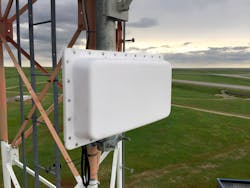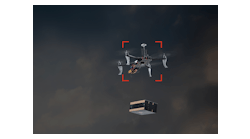Layer Surveillance Radar Technology into Physical Security Solutions for Real-Time Detection of Threats at Airport Sites
Large, medium, and even small-sized airports operate huge physical locations with extensive perimeters and a host of critical areas that must be guarded against a number of intrusions. A few of the primary vulnerabilities of most airport perimeters include the vast size of the perimeter and, in some cases, remote or isolated areas around the airport or airport property that are infrequently patrolled. Because of these vulnerabilities, humans on foot or in vehicles can pose serious threats to life and property, not to mention the financial and public relations costs arising from airport shutdowns, theft, and vandalism.
Another more recent concern for airports is the growing frequency of drone incursions into airport airspace, with the potential danger to life and property should a drone hit a plane, fly into an engine, or otherwise cause airspace issues. It is no secret that several airports have been shut down or forced to ground flights over the past several months due to drone reports in and around restricted airspace near airports.
According to a study from researchers at Embry-Riddle Aeronautical University, the FAA recorded 6,117 reports of near encounters, whether intentional or not, between manned and unmanned aircraft within the National Air Space from 2014 to 2018. These statistics are cause for significant safety concerns for airports. Dubai International Airport, as well as both Heathrow and Gatwick International Airports in London, have already felt the effects of drone sightings in their airspace with grounded flights and delays. Of course, these are just the most well known incidents.
To protect against the dangers of ground and air intruders and other threats at airports, security teams are turning to more robust physical security solutions to monitor both ground and low-altitude airspace for intrusions. Common physical security practices include physical fence barriers, video cameras, access control, audible alarms, and more. The best recommendation for airports searching to increase physical security of a site is a layered protection strategy that integrates several of these technologies into a larger physical security solution.
According to the Program for Applied Research in Airport Security (PARAS), which is managed by the National Safe Skies Alliance, these layered, integrated solutions should deter/delay, detect, assess/classify, locate, and identify potential or actual intrusions of the airport perimeter in a timely manner and increase the response time for security personnel to stop an intrusion or detain the suspect. As part of the December 2018 Guidance for Airport Perimeter Security Report, PARAS defines these actions as:
- Deter (stop an intrusion before it happens)
- Detect (know if an intrusion is taking place)
- Delay (slow down the intrusion to allow for effective law enforcement response)
- Deny/Respond (barriers, stand-off distances, response forces deployment)
- Defend (protect an asset or assets by shielding them from potential harm)
- Defeat (personnel to defeat or neutralize an intruder)
- Response (provide situational awareness information to responders)
- Recover (ensure that all processes and systems are operating in a nominal fashion and that the threat/incident is contained)
Layering surveillance radar into physical security solutions
Commonly missing from most airports’ layered physical security strategy is one of the first layers – namely, the long-range detection of intruders prior to their arriving at or breaching the airport’s perimeters or airspace.
One technology that has been used for long-range detection in defense and critical infrastructure sectors, but is only recently becoming well known in airport security circles, is long-range surveillance radar.
Simply put, radar is a sensor that uses radio waves to detect movement within line of sight in an environment. Due to the complexity of most radar systems, the radar can commonly detect the presence, position, and motion of objects in its vicinity such as humans, animals, vehicles, aircraft, ships, vehicles, and drones, depending on the radar provider.
These radar systems typically provide real-time surveillance and all-weather detection and tracking sensors unaffected rain, snow, wind, or other environmental factors. Perimeter security radar systems are used to monitor large areas, even hundreds of acres with a single sensor, while detecting and tracking targets from 1-15 km ranges. The result is that airports can be notified and provided with the real-time information needed to respond to potential threats as they happen.
There are advantages and disadvantages to using surveillance radar systems as part of a layered physical security solution. However, in most cases, the pros highly outweigh the cons.
Advantages to surveillance radar technology
One advantage of surveillance radar solutions is the ability to provide detection beyond a perimeter. Because radar systems usually have a range much farther than the perimeter of a site, airports can use the radar technology to detect potential security threats prior to the threat or intruder reaching the perimeter of the airport. Being able to detect threats at long distances allows for earlier warning and the potential for mitigation prior to the threat causing airport shutdowns, flight delays, negative PR, and other issues. Radar solutions currently available have proven success at detecting intrusions at distances that provided airport security personnel with more than 20 minutes’ notice prior to the intruder’s arrival at the perimeter fence. As a result, security stakeholders can assess the situation and take proactive steps to interdict intruders before they cause serious problems.
A second advantage to today’s advanced surveillance radar solutions is their ability to classify potential targets in real time. This feature means the radar collects feature data, which is run through a “classification engine.” This real-time process enables the radar system to make probability-based determinations about whether the target is a person, animal, ground vehicle, aircraft, or even a drone. This classification intelligence not only allows security personnel more time to focus on real threats, but it also reduces false alarm rates by avoiding alarms on objects not considered threatening.
Radar solutions also provide the ability to create and configure alarm zones, also commonly called geofences, within which all or only specific classifications of targets will be alarmed on when targets enter those zones. Combining alarm zones with the capability to set up custom rules means airports can use radar for focused surveillance, automated monitoring, and instantaneous triggering of deterrent and responsive actions. Without security operators involved in the surveillance process, this capability enhances situational awareness, while reducing the amount of time and human resources required reviewing alarms that are not of concern.
Lastly, surveillance radar technology used for airport perimeter protection is attractive from a cost standpoint, as radar is an effective technology option for providing the greatest surveillance coverage of physical areas with the fewest sensors and associated supporting infrastructure. For example, a single mid-range radar unit, which is currently in use at multiple airports, provides surveillance coverage of an area that requires more than 20 fixed thermal cameras, 20 fixed HD cameras, and 1 pan-tilt-zoom (PTZ) camera to cover using only cameras. When considering the costs to purchase the cameras, ongoing maintenance costs, and the infrastructure to support those cameras, radar provides a superior coverage-to-cost ratio than cameras and other detection technologies that require more sensor units and infrastructure. With high value and superior capabilities for automated monitoring, long-range detection, target classification, etc., radar is an effective technology for large sites like airports.
Disadvantages to surveillance radar technology
One disadvantage to radar technology is the need for line of sight of an object. Similar to a camera, radar technology can have difficulty in detecting and tracking objects through buildings, dense foliage, or largely uneven terrain. Radar technology works best and provides greatest coverage in environments with lots of open spaces. To compensate for line-of-sight blockages, radars can be positioned at sufficient heights and at specific angles to provide coverage. Additional radar units may also be used to ensure full coverage of surveillance areas.
Radar technology also does not, in and of itself, provide visual verification of alarms. However, airports and other radar users typically integrate radar with video cameras to create a more complete surveillance capability in which the radar detects targets at long ranges and then automatically slews a camera to the target for visual verification of what the radar has detected.
Mike Stokes is the President of Observation Without Limits (OWL), a 2D and 3D surveillance radar solution provider for critical infrastructure sites. OWL manufactures radars for sites of all sizes, including 3D radars for drone detection applications. For more information, visit owlknows.com.


